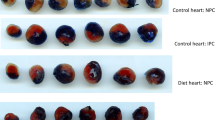Abstract
Long-chain acylcarnitines, such as palmitoyl-L-carnitine (PALCAR), are known to accumulate in the myocardium during ischemia. We examined whether exogenous PALCAR modifies the myocardial levels of high-energy phosphates (HEP) and free fatty acids (FFA) in the heart, and whetherd-cis-diltiazem andl-cis-diltiazem, an optical isomer having less potent Ca2+ channel blocking action thand-cis-diltiazem, attenuate the PALCAR-induced myocardial changes. Rat hearts were perfused aerobically at a constant flow according to the Langendorff's technique, while being paced electrically. PALCAR (5 μM) decreased the tissue levels of adenosine triphosphate and creatine phosphate and increased the tissue level of adenosine monophosphate, and produced mechanical dysfunction. In addition, PALCAR (5 μM) increased markedly the tissue levels of FFA, especially those of arachidonic and palmitoleic acids, and the release of creatine kinase (CK) from the myocardium. These alterations in the myocardial levels of HEP and FFA induced by PALCAR were significantly attenuated byd-cis-diltiazem (15 μM) orl-cis-diltiazem (15 μM). Both drugs also attenuated the PALCAR-induced CK release. The present study demonstrates that PALCAR modifies the tissue levels of HEP and FFA in the heart and that bothd-cis andl-cis-diltiazem protect the myocardium against the PALCAR-induced changes through mechanisms other that Ca2+ channel blocking action.
Similar content being viewed by others
References
Bergmeyer HU (1974) Methods of enzymatic analysis. Academic Press, New York: 1777–1781, 2101–2110, 2127–2131
Bergmeyer HU (1974) Method of enzymatic analysis. Academic Press, New York: 789–793
Busselen P, sercu D, Verdonck F (1988) Exogenous plamitoyl carnitine and membrane damage in rat hearts. J Mol Cell Cardiol 20: 905–916
Chien KR, Han A, Sen A, Buja LM, Willerson JT (1984) Accumulation of unesterified arachidonic acid in ischemic canine myocardium. Relationship to a phosphatidylcholine deacylation-reacylation cycle and the depletion of membrane phospholipids. Circ Res 54: 313–322
Corr PB, Creer MH, Yamada KA, Saffitz JE, Sobel BE (1989) Prophylaxis of early ventricular fibrillation by inhibition of acylcarnitine accumulation. J Clin Invest 83: 927–936
Corr PB, Saffitz JE, Sobel BE (1987) Lysophospholipids, long chain acylcarnitines and membrane dysfunction in the ischaemic heart. Basic Res Cardiol 82 (Suppl 1): 199–208
Da Torre SD, Creer MH, Pogwizd SM, Corr PB (1981) Amphipathic lipid metabolites and their relation to arrhythmogenesis in the ischemic heart. J Mol Cell Cardiol 23 (Suppl I): 11–22
Hara A, Hashizume H, Abiko Y (1996) Dilazep and its derivative, K-7259, attenuate mechanical derangement induced by palmitoyl-L-carnitine in the isolated, perfused rat heart. J Pharmacol Exp Ther 279: 32–38
Hara Y, Nakamura K, Nasa Y, Ichihara K, Abiko Y (1990) Changes in myocardial nonesterfied fatty acids during ischemia and reperfusion in isolated, perfused, working rat hearts. Heart Vessels 6: 21–31
Hoque ANE, Hoque N, Hashizume H, Abiko Y (1995) A study on dilazep: II. Dilazep attenuates lysophosphatidylcholine-induced mechanical and metabolic derangements in the isolated, working rat heart. Jpn J Pharmacol 67: 233–241
Miura I, Hashizume H, Abiko Y (1988) Propranolol inhibits accumulation of non-esterified fatty acids in the ischemic dog hearts. Eur J Pharmacol 152: 281–288
Nasa Y, Ichihara K, Abiko Y (1990) Bothd-cis- andl-cis-diltiazem have anti-ischemic action in the isolated, perfused working rat heart. J Pharmacol Exp Ther 255: 680–689
Nasa Y, Ichihara K, Abiko Y (1990) Myocardial non-esterified fatty acids during normoxia and ischemia in Langendorff and working rat hearts. Jpn J Pharmacol 53: 129–133
Nasa Y, Ichihara K, Yoshida R, Abiko Y (1992) Positive inotropic and negative chronotropic effects of (−)-cis-diltiazem in rat isolated atria. Br J Pharmacol 255: 696–702
Patmore L, Duncan GP, Spedding M (1989) Interaction of palmitoyl carnitine with calcium antagonists in myocytes. Br J Pharmacol 97: 443–450
Piper MH, Sezer O, Schwartz P, Hütter JF, Schweickhardt C, Spieckermann PG (1984) Acyl-carnitine effects on isolated cardiac mitochondria and erythrocytes. Basic Res Cardiol 79: 186–198
Pitts BJR, Okhuysen CH (1984) Effects of palmitoyl carnitine and LPC on cardiac sarcolemmal Na+−K+-ATPase. Am J Physiol 247: H840-H846
Sargent CA, Vesterqvist O, Ogletree M, Grover GJ (1993) Effects of endogenous and exogenous lysophosphatidylcholine in isolated perfused rat hearts. J Mol Cell Cardiol 25: 905–913
Sasaki Y, Morita T, Takeyama S (1984) Effects of diltiazem on the physicochemical properties of rat erythrocyte and liposome membrane: comparison with pentoxifylline and propranolol. Jpn J Pharmacol 34: 417–427
Shen J-B, Pappano AJ (1995) Palmitoyl-L-carnitine acts like ouabain on voltage, current, and contraction in guinea pig ventricular cells. Am J Physiol 268: H1027-H1036
Shikama H, Noshiro O, Ohta A, Ohata I (1988) Effects of acylcarnitine-transferase inhibitors on adenine nucleotide metabolism and ischemic tissue injury in isolated perfused rat heart. Jpn Heart J 29: 723–734
Undrovinas AI, Fleidervish IA, Makielski JC (1992) Inward sodium current at resting potentials in single cardiac myocytes induced by the ischemic metabolite lysophosphatidylcholine. Circ Res 71: 1231–1241
Van Bilsen M, Van der Vusse GJ, Willemsen PHM, Coumans WA, Roemen THM, Reneman RS (1989) Lipid alterations in isolated, working rat hearts during ischemia and reperfusion: its relation to myocardial damage. Circ Res 64: 304–314
Wu J, Corr PB (1992) Influence of longchain acylcarnitines on voltage-dependent calcium current in adult ventricular myocytes. Am J Physiol 263: H410-H417
Wu J, Corr PB (1994) Palmitoyl carnitine modifies sodium currents and induces transient inward current in ventricular myocytes. Am J Physiol 266: H1034-H1046
Yamada KA, McHowat J, Yan G-X, Donahue K, Peirick J, Kléber AG, Corr PB (1994) Cellular uncoupling induced by accumulation of long-chain acylcarnitine during ischemia. Circ Res 74: 83–95
Author information
Authors and Affiliations
Rights and permissions
About this article
Cite this article
Xiao, C.Y., Chen, M., Hara, A. et al. Palmitoyl-L-carnitine modifies the myocardial levels of high-energy phosphates and free fatty acids. Basic Res Cardiol 92, 320–330 (1997). https://doi.org/10.1007/BF00788944
Received:
Revised:
Accepted:
Issue Date:
DOI: https://doi.org/10.1007/BF00788944




